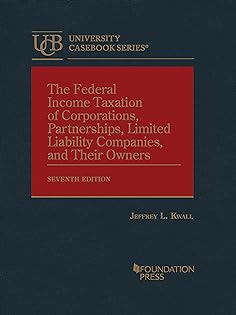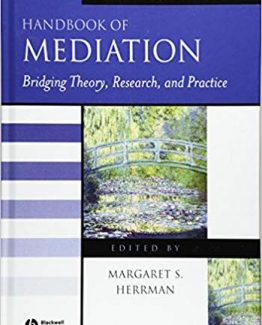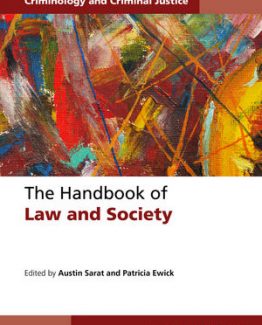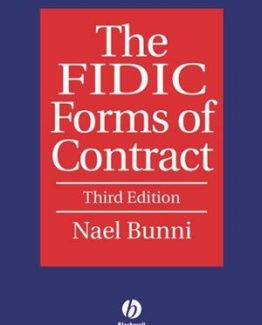Kwall’s The Federal Income Taxation of Corporations, Partnerships, Limited Liability Companies, and Their Owners 7th Edition by Jeffrey L. Kwall, ISBN-13: 978-1636594651
[PDF eBook eTextbook]
- Publisher: Foundation Press; 7th edition (October 19, 2022)
- Language: English
- ISBN-10: 1636594654
- ISBN-13: 978-1636594651
An up-to-date response to the trend toward teaching corporate tax and partnership tax in a consolidated course, the 7th edition incorporates the Inflation Reduction Act of 2022 and updates, expands, and clarifies the prior edition. The 7th edition continues to use a unique mix of cases and rulings focusing on tax issues in a business planning context. The creative, student-friendly structure includes many examples and problems. The material can be taught in either an integrated manner or entity-by-entity. The 7th edition includes many examples and problems.
Parts I-IV are designed for an intermediate three or four credit course on C Corporations, S Corporations, and partnerships. The material can be taught in either an integrated manner or entity-by-entity.
Parts V-VI are designed for an advanced, two or three credit course in asset and stock sales, corporate reorganizations, and spin-offs.
The casebook is also appropriate for a three or four credit intermediate corporate tax course by omitting the partnership chapters. The book is suitable for both the J.D. and LL.M levels.
Selected Changes to the 7th Edition Include:
– An explanation of the Inflation Reduction Act of 2022’s corporate alternative minimum tax.
– An explanation of the Inflation Reduction Act of 2022’s corporate excise tax on certain redemptions.
– An updated discussion of the limitation on the business interest deduction.
– The addition of a recent case illustrating pitfalls of a closing-of-the-books election.
– An updated discussion of the qualified business income deduction.
– The addition of a Form 2553 to highlight effective date issues of an S election.
– An augmented discussion of the relation of the Rickey case to IRC § 302(c)(2)(C).
– A new illustration of the qualified small business stock exclusion.
– A revision of material on the deductibility of partnership losses.
– An updated discussion of bonus depreciation.
Table of Contents:
TABLE OF CONTENTS
PREFACE TO THE SEVENTH EDITION ………………………………………………………….V
PREFACE TO THE FIRST EDITION……………………………………………………………. VII
TABLE OF CASES ……………………………………………………………………………….. XXIX
TABLE OF STATUTES ………………………………………………………………………… XXXIII
TABLE OF REGULATIONS ……………………………………………………………………. XLIII
TABLE OF I.R.S. RULINGS ………………………………………………………………….. XLIX
TABLE OF AUTHORITIES ………………………………………………………………………….LI
PART ONE. INTRODUCTION
Chapter 1. Perspective ………………………………………………………………………. 3
A. The Business as an Entity Under State Law ……………………………………. 3
B. The Business as a Taxpaying Entity—the C Corporation …………………. 6
C. The Business as a Tax Accounting Entity—the S Corporation and the
Partnership……………………………………………………………………………………. 9
D. The Uniform Taxation of All Business Income—Preview of the
Future? ……………………………………………………………………………………….. 10
Treasury Department Report Integration of the Individual and
Corporate Tax Systems ………………………………………………………….. 11
Notes …………………………………………………………………………………………… 13
PART TWO. OPERATIONS
Chapter 2. C Corporation Operations ……………………………………………..17
A. Corporate Income Tax ………………………………………………………………….. 19
1. Tax Rates ……………………………………………………………………………… 19
2. Scope of Corporate Gross Income ……………………………………………. 19
a. Inclusionary Aspects—Income from Services……………………. 19
Haag v. Commissioner ……………………………………………………. 19
Notes …………………………………………………………………………….. 24
b. Inclusionary Aspects—Gains from Property …………………….. 26
General Utilities & Operating Co. v. Helvering ………………… 27
Notes …………………………………………………………………………….. 30
c. Exclusionary Aspects—General ………………………………………. 31
Castner Garage, Limited v. Commissioner Universal Motor
Company v. Commissioner Island Securities, Limited,
A Dissolved Corporation v. Commissioner ………………… 31
Notes …………………………………………………………………………….. 34
d. Exclusionary Aspects—Corporate Specific ……………………….. 34
Notes …………………………………………………………………………….. 34
3. Scope of Corporate Deductions ……………………………………………….. 35
a. Reducing Double Taxation ………………………………………………. 36
Elliotts, Inc. v. Commissioner …………………………………………. 36
Notes …………………………………………………………………………….. 43
Fin Hay Realty Co. v. United States ………………………………… 45
Notes …………………………………………………………………………….. 50
Maxwell v. Commissioner Hi Life Products, Inc. v.
Commissioner …………………………………………………………. 53
Notes …………………………………………………………………………….. 57
b. Inhibiting Triple Taxation ………………………………………………. 57
Litton Industries, Inc. v. Commissioner …………………………… 58
Notes …………………………………………………………………………….. 61
Corporate Penalty Taxes ………………………………………………………………. 63
1. Accumulated Earnings Tax ……………………………………………………. 63
United States v. Donruss Co. …………………………………………………. 64
Snow Manufacturing Company v. Commissioner …………………….. 67
Notes ……………………………………………………………………………………. 74
2. Personal Holding Company Tax …………………………………………….. 77
Irving Berlin Music Corporation v. United States ……………………. 78
Darrow v. Commissioner ……………………………………………………….. 81
Notes ……………………………………………………………………………………. 84
Consequences of Operating Loss……………………………………………………. 86
Notes …………………………………………………………………………………………… 87
Distinguishing Corporation from Shareholders ……………………………… 87
Commissioner v. Bollinger ……………………………………………………………. 87
Note …………………………………………………………………………………………….. 92
Chapter 3. S Corporation Operations …………………………………………….. 95
A. Computation of Gross Income and Deductions ……………………………….. 95
Revenue Ruling 93–36 ………………………………………………………………….. 98
Notes …………………………………………………………………………………………… 99
B. Allocation to Shareholders ………………………………………………………….. 100
1. Shareholders Taxed When Income Earned ……………………………. 100
Knott v. Commissioner ………………………………………………………… 100
Notes ………………………………………………………………………………….. 101
2. Rigid Allocation Rule …………………………………………………………… 102
Notes ………………………………………………………………………………….. 105
Manfre v. May …………………………………………………………………….. 106
Notes ………………………………………………………………………………….. 109
C. Deduction for Qualified Business Income …………………………………….. 110
Notes …………………………………………………………………………………………. 114
D. Consequences of Operating Loss………………………………………………….. 114
Selfe v. United States …………………………………………………………………. 116
Estate of Leavitt v. Commissioner ……………………………………………….. 120
Notes …………………………………………………………………………………………. 125
Hitchins v. Commissioner …………………………………………………………… 128
Note …………………………………………………………………………………………… 131
E. Distinguishing S Corporation from C Corporation ………………………… 131
1. Small Business Corporation …………………………………………………. 132
a. Not More than 100 Shareholders …………………………………… 132
Revenue Ruling 94–43 ………………………………………………….. 132
Notes …………………………………………………………………………… 133
b. No Ineligible Shareholders ……………………………………………. 133
IRS Letter Ruling 9138025 ……………………………………………. 133
Notes …………………………………………………………………………… 134
Not More than One Class of Stock …………………………………. 136
Paige v. United States …………………………………………………… 136
Notes …………………………………………………………………………… 139
2. The Election ………………………………………………………………………… 142
Leather v. Commissioner ……………………………………………………… 143
Notes ………………………………………………………………………………….. 145
Transitional Problems ………………………………………………………………… 146
1. Built-In Gains ……………………………………………………………………… 147
2. Accumulated C Earnings ……………………………………………………… 150
Notes ………………………………………………………………………………….. 153
3. Net Operating Loss ……………………………………………………………… 154
Rosenberg v. Commissioner …………………………………………………. 154
Notes ………………………………………………………………………………….. 157
Chapter 4. Partnership Operations ……………………………………………….159
A. Computation of Gross Income and Deductions ……………………………… 159
B. Allocation to Partners …………………………………………………………………. 162
1. Partners Taxed When Income Earned …………………………………… 162
Burke v. Commissioner ………………………………………………………… 163
Notes ………………………………………………………………………………….. 164
2. Flexible Allocation Rule ……………………………………………………….. 165
a. Introduction to Economic Effect …………………………………….. 167
Orrisch v. Commissioner ………………………………………………. 168
Notes …………………………………………………………………………… 174
b. Introduction to Capital Accounts …………………………………… 174
Note …………………………………………………………………………….. 176
c. General Test for Economic Effect …………………………………… 176
d. Alternate Test for Economic Effect ………………………………… 178
e. Substantiality ………………………………………………………………. 180
(1) Transitory Allocations and Shifting Tax
Consequences ………………………………………………………… 180
Notes…………………………………………………………………….. 183
(2) General Restriction ……………………………………………….. 184
Note ……………………………………………………………………… 185
Partner’s Interest in Partnership …………………………………… 186
Note …………………………………………………………………………….. 186
C. Deduction for Qualified Business Income …………………………………….. 187
Notes …………………………………………………………………………………………. 191
D. Allowance of Allocated Deduction/Loss ………………………………………… 191
Notes …………………………………………………………………………………………. 197
Garcia v. Commissioner ………………………………………………………………. 200
Note …………………………………………………………………………………………… 203
E. Modifying an Allocation ………………………………………………………………. 204
Lipke v. Commissioner ……………………………………………………………….. 204
Notes …………………………………………………………………………………………. 207
F. Distinguishing Partnership from Proprietorship ………………………….. 208
Revenue Ruling 75–374 ………………………………………………………………. 208
Barron v. Commissioner ……………………………………………………………… 209
Notes …………………………………………………………………………………………. 211
Distinguishing Partnership from Taxpaying Entity ……………………… 212
1. Non-Publicly Traded Partnerships ……………………………………….. 212
Simplification of Entity Classification Rules …………………………. 213
Notes ………………………………………………………………………………….. 215
Revenue Ruling 99–5 …………………………………………………………… 216
Note ……………………………………………………………………………………. 217
2. Publicly Traded Partnerships ………………………………………………. 217
Notes ………………………………………………………………………………….. 218
PART THREE. DISTRIBUTIONS
Chapter 5. C Corporation Distributions ………………………………………..223
A. One-Side Distribution …………………………………………………………………. 223
1. Dividend to the Extent of Earnings & Profits ………………………… 223
a. Conceptualizing Earnings & Profits ………………………………. 224
Notes …………………………………………………………………………… 225
b. Quantifying Earnings & Profits …………………………………….. 225
Revenue Ruling 74–164 ………………………………………………… 225
Notes …………………………………………………………………………… 227
c. Qualified Dividend Income ……………………………………………. 230
Note …………………………………………………………………………….. 231
2. Camouflaged One-Side Distribution ……………………………………… 231
a. Loan or Distribution……………………………………………………… 232
Jaques v. Commissioner ……………………………………………….. 232
Notes …………………………………………………………………………… 235
b. Business or Personal Use of Corporate Property …………….. 237
Resenhoeft v. Commissioner …………………………………………. 237
Notes …………………………………………………………………………… 242
Boulware v. United States …………………………………………….. 242
Notes …………………………………………………………………………… 246
c. Discharge of Corporate or Personal Obligation……………….. 247
Sullivan v. United States ………………………………………………. 247
Note …………………………………………………………………………….. 248
Revenue Ruling 69–608 ………………………………………………… 248
Notes …………………………………………………………………………… 251
B. Redemption ……………………………………………………………………………….. 251
1. Distinguishing Sale from One-Side Distribution ……………………. 253
a. Not Essentially Equivalent to a Dividend ………………………. 253
United States v. Davis ………………………………………………….. 253
Notes …………………………………………………………………………… 257
Revenue Ruling 81–289 ………………………………………………… 257
Notes …………………………………………………………………………… 258
b. Attribution Rules………………………………………………………….. 259
c. Substantially Disproportionate Redemption …………………… 261
Revenue Ruling 87–88 ………………………………………………….. 261
Glacier State Electric Supply Company v.
Commissioner ……………………………………………………….. 263
Notes …………………………………………………………………………… 268
Complete Termination of Interest ………………………………….. 271
(1) Sale and/or Redemption …………………………………………. 271
Zenz v. Quinlivan ………………………………………………….. 271
Note ……………………………………………………………………… 273
Arnes v. United States …………………………………………… 273
Notes…………………………………………………………………….. 275
Arnes v. Commissioner ………………………………………….. 275
Notes…………………………………………………………………….. 279
(2) Attribution Issues ………………………………………………….. 280
Lynch v. Commissioner ………………………………………….. 281
Notes…………………………………………………………………….. 285
Rickey v. United States ………………………………………….. 287
Notes…………………………………………………………………….. 292
IRS Notice 2001–45 ……………………………………………….. 294
Notes…………………………………………………………………….. 296
e. Impact on Earnings & Profits ………………………………………… 296
Notes …………………………………………………………………………… 297
2. Sale to Related Corporation …………………………………………………. 298
Coyle v. United States …………………………………………………………. 299
Notes ………………………………………………………………………………….. 303
Liquidation ………………………………………………………………………………… 306
Note …………………………………………………………………………………………… 307
1. Taxable Liquidation …………………………………………………………….. 307
Rendina v. Commissioner …………………………………………………….. 308
Notes ………………………………………………………………………………….. 311
Ethel M. Schmidt v. Commissioner ………………………………………. 312
Notes ………………………………………………………………………………….. 316
Ford v. United States …………………………………………………………… 317
Note ……………………………………………………………………………………. 319
2. Subsidiary Liquidation ………………………………………………………… 319
George L. Riggs, Inc. v. Commissioner ………………………………….. 319
Revenue Ruling 70–106 ……………………………………………………….. 324
Notes ………………………………………………………………………………….. 325
Sale of C Corporation ………………………………………………………………….. 326
1. Death of Owner Before Sale—IRC § 1014 ……………………………… 328
2. Qualified Small Business Stock—I.R.C. § 1202 ……………………… 330
IRS Letter Ruling 202144026 ……………………………………………….. 330
Note ……………………………………………………………………………………. 333
Chapter 6. S Corporation Distributions ………………………………………..335
A. One-Side Distribution …………………………………………………………………. 335
1. No Accumulated Earnings & Profits ……………………………………… 336
Notes ………………………………………………………………………………….. 338
2. Accumulated Earnings & Profits ………………………………………….. 338
Notes ………………………………………………………………………………….. 340
3. Camouflaged One-Side Distribution ……………………………………… 341
David E. Watson, P.C. v. United States ………………………………… 341
Note ……………………………………………………………………………………. 344
Redemption ……………………………………………………………………………….. 344
Revenue Ruling 95–14 ………………………………………………………………… 345
Note …………………………………………………………………………………………… 349
Liquidation ………………………………………………………………………………… 349
Note …………………………………………………………………………………………… 350
Chapter 7. Partnership Distributions ……………………………………………351
A. Current Distribution …………………………………………………………………… 351
1. Distribution of Money ………………………………………………………….. 351
a. Actual Distribution ………………………………………………………. 351
Revenue Ruling 66–94 ………………………………………………….. 353
b. Reduction in Partnership Liabilities ……………………………… 354
(1) Change in Form of Partnership ………………………………. 355
Revenue Ruling 84–52 …………………………………………… 355
Note ……………………………………………………………………… 356
(2) Cancellation of Partnership Indebtedness……………….. 357
Revenue Ruling 94–4 …………………………………………….. 358
Note ……………………………………………………………………… 359
IRS Technical Advice Memorandum 9739002 ………….. 359
Note ……………………………………………………………………… 361
2. Distribution of Property, Other than Money ………………………….. 361
Notes ………………………………………………………………………………….. 362
3. Distribution of Marketable Securities …………………………………… 363
Partnership Distributions of Marketable Securities ………………. 364
B. Distribution in Liquidation of Partner’s Interest ………………………….. 366
1. General Rules ……………………………………………………………………… 366
2. Identifying the Taxable Event ……………………………………………… 367
Weiss v. Commissioner ………………………………………………………… 367
Notes ………………………………………………………………………………….. 371
3. Distinguishing Liquidation of Interest from Sale …………………… 371
Crenshaw v. United States …………………………………………………… 372
Notes ………………………………………………………………………………….. 375
4. Service Partnership …………………………………………………………….. 376
Tolmach v. Commissioner ……………………………………………………. 379
Notes ………………………………………………………………………………….. 385
5. Impact of § 751 Assets …………………………………………………………. 387
a. Sale of Interest …………………………………………………………….. 387
b. Liquidation of Interest ………………………………………………….. 388
Note …………………………………………………………………………….. 393
c. Disposition of Distributed Property ……………………………….. 394
6. Partnership Level Adjustments ……………………………………………. 394
Jones v. United States …………………………………………………………. 396
Notes ………………………………………………………………………………….. 400
C. Termination of Partnership ………………………………………………………… 402
Crawford v. Commissioner ………………………………………………………….. 402
Notes …………………………………………………………………………………………. 404
Revenue Ruling 99–6 ………………………………………………………………….. 405
Note …………………………………………………………………………………………… 407
PART FOUR. CONTRIBUTIONS
Former Regulation on Exchanges ……………………………………………………….. 409
Notes ………………………………………………………………………………………………… 410
Chapter 8. C Corporation Contributions ………………………………………411
A. Transfer of Property for Stock……………………………………………………… 411
1. Deferral of Gain or Loss ……………………………………………………….. 412
Kamborian v. Commissioner ………………………………………………… 412
Notes ………………………………………………………………………………….. 418
Intermountain Lumber Company v. Commissioner ……………….. 419
Notes ………………………………………………………………………………….. 423
James v. Commissioner Talbot v. Commissioner……………………. 423
Notes ………………………………………………………………………………….. 426
2. Basis as Gain/Loss Preservation Mechanism ………………………… 426
3. Assignment of Income ………………………………………………………….. 428
Revenue Ruling 80–198 ……………………………………………………….. 428
Notes ………………………………………………………………………………….. 431
B. Transfer of Property for Other Consideration ………………………………. 431
1. Receipt of Property in Addition to Stock ……………………………….. 432
Revenue Ruling 68–55 …………………………………………………………. 433
Note ……………………………………………………………………………………. 435
2. Relief from Liabilities ………………………………………………………….. 435
Lessinger v. Commissioner …………………………………………………… 437
Peracchi v. Commissioner…………………………………………………….. 442
Notes ………………………………………………………………………………….. 444
Revenue Ruling 95–74 …………………………………………………………. 446
Note ……………………………………………………………………………………. 449
C. Contribution to Capital ………………………………………………………………. 449
Commissioner v. Fink …………………………………………………………………. 449
Note …………………………………………………………………………………………… 453
Chapter 9. S Corporation Contributions ……………………………………….455
A. Transfer of Property for Stock……………………………………………………… 455
1. Deferral of Gain or Loss ……………………………………………………….. 455
Notes ………………………………………………………………………………….. 455
2. Basis as Gain/Loss Preservation Mechanism ………………………… 456
3. Assignment of Income ………………………………………………………….. 457
4. Characterization Issues ……………………………………………………….. 458
B. Transfer of Property for Other Consideration ………………………………. 459
Chapter 10. Partnership Contributions ………………………………………..461
A. Transfer of Property for Partnership Interest ………………………………. 461
1. Deferral of Gain or Loss ……………………………………………………….. 462
a. Property and Exchange Requirements …………………………… 462
United States v. Stafford ………………………………………………. 462
Notes …………………………………………………………………………… 466
b. Receipt of a Profits Interest …………………………………………… 467
Diamond v. Commissioner …………………………………………….. 467
Note …………………………………………………………………………….. 471
Campbell v. Commissioner ……………………………………………. 472
Note …………………………………………………………………………….. 478
Revenue Procedure 93–27……………………………………………… 479
Notes …………………………………………………………………………… 480
2. Basis as Gain/Loss Preservation Mechanism ………………………… 480
3. Assignment of Income ………………………………………………………….. 483
Schneer v. Commissioner …………………………………………………….. 483
Note ……………………………………………………………………………………. 489
a. Allocation of Pre-Contribution Gain or Loss …………………… 489
Notes …………………………………………………………………………… 491
b. Distribution of Contributed Property …………………………….. 492
4. Characterization Issues ……………………………………………………….. 493
Transfer of Property for Other Consideration ………………………………. 494
Otey v. Commissioner …………………………………………………………………. 494
Notes …………………………………………………………………………………………. 498
Partnership Anti-Abuse Rule ………………………………………………………. 500
IRS Chief Counsel Advice Memorandum 200650014 …………………….. 501
PART FIVE. CORPORATE DISPOSITIONS AND ACQUISITIONS
Chapter 11. Taxable Transfers ……………………………………………………….507
A. Perspective ………………………………………………………………………………… 509
1. The Time Value of Money …………………………………………………….. 510
B. Asset Transfer ……………………………………………………………………………. 513
1. Tax Consequences to Seller ………………………………………………….. 513
Williams v. McGowan ………………………………………………………….. 513
Notes ………………………………………………………………………………….. 514
Martin Ice Cream Company v. Commissioner ……………………….. 515
Notes ………………………………………………………………………………….. 518
2. Tax Consequences to Buyer………………………………………………….. 519
a. Residual Method of Allocation ……………………………………….. 520
Allocation of Purchase Price in Certain Sales of Assets
(* * * New Section 1060 of the Code) ……………………….. 520
Notes …………………………………………………………………………… 522
b. Uniform Amortization of Intangible Assets ……………………. 522
Amortization of Goodwill and Certain Other Intangibles
(* * * New Section 197 of the Code)…………………………. 523
Notes …………………………………………………………………………… 525
3. Evaluating the Relative Positions of Seller and Buyer in an
Asset Sale …………………………………………………………………………… 525
4. Contingent Liabilities ………………………………………………………….. 528
IRS Technical Advice Memorandum 9721002 ……………………….. 528
Notes ………………………………………………………………………………….. 532
C. Stock Transfer ……………………………………………………………………………. 533
1. Tax Consequences to Seller ………………………………………………….. 533
2. Tax Consequences to Buyer………………………………………………….. 533
a. Historical Perspective …………………………………………………… 533
Kimbell-Diamond Milling Company v. Commissioner …….. 533
Notes …………………………………………………………………………… 535
The I.R.C. § 338 General Election ………………………………….. 536
Notes …………………………………………………………………………… 538
Evaluating the Relative Positions of Seller and Buyer in a
Stock Sale (with § 338 Election) ……………………………………………. 538
Evaluating the Relative Positions of Seller and Buyer in a
Stock Sale (Without § 338 Election) ………………………………………. 542
Notes ………………………………………………………………………………….. 542
Recovery Group, Inc. v. Commissioner ………………………………….. 543
The I.R.C. § 338(h)(10) Election ……………………………………………. 549
Notes ………………………………………………………………………………….. 550
Chapter 12. Nontaxable Transfers …………………………………………………553
A. Perspective ………………………………………………………………………………… 553
Cottage Savings Association v. Commissioner ……………………………… 554
Notes …………………………………………………………………………………………. 560
1. Common Law Doctrines ……………………………………………………….. 562
a. Continuity of Proprietary Interest …………………………………. 563
John A. Nelson Co. v. Helvering…………………………………….. 563
Le Tulle v. Scofield ……………………………………………………….. 564
Notes …………………………………………………………………………… 566
b. Continuity of Business Enterprise …………………………………. 567
c. Business Purpose and Plan of Reorganization ………………… 568
2. The Statutory Scheme …………………………………………………………. 570
B. Asset Transfer ……………………………………………………………………………. 571
1. Transfer of “Substantially All” the Assets ……………………………… 572
Helvering v. Elkhorn Coal Co……………………………………………….. 572
Notes ………………………………………………………………………………….. 577
2. Receipt of Solely Voting Stock ………………………………………………. 579
a. Liabilities of the Transferor…………………………………………… 579
United States v. Hendler ………………………………………………. 579
United States v. Hendler ………………………………………………. 582
Notes …………………………………………………………………………… 583
b. Money or Other Property ………………………………………………. 585
Revenue Ruling 73–102 ………………………………………………… 585
Notes …………………………………………………………………………… 587
3. Liquidation of the Transferor ……………………………………………….. 588
Revenue Procedure 89–50 ……………………………………………………. 589
Notes ………………………………………………………………………………….. 590
4. Creative Application ……………………………………………………………. 591
IRS Letter Ruling 200709037 ……………………………………………….. 591
Notes ………………………………………………………………………………….. 593
5. The Nondivisive D Reorganization ……………………………………….. 594
C. Stock Transfer ……………………………………………………………………………. 595
1. “Control” Immediately After the Acquisition …………………………. 596
Revenue Ruling 56–613 ……………………………………………………….. 596
Notes ………………………………………………………………………………….. 597
2. Receipt of Solely Voting Stock ………………………………………………. 598
a. Liabilities of the Target ………………………………………………… 598
Revenue Ruling 79–89 ………………………………………………….. 598
Notes …………………………………………………………………………… 600
Money or Other Property ………………………………………………. 600
Revenue Ruling 68–285 ………………………………………………… 600
Notes …………………………………………………………………………… 602
Chapman v. Commissioner ……………………………………………. 603
Notes …………………………………………………………………………… 611
Miscellaneous Announcement 5425 ……………………………….. 612
Notes …………………………………………………………………………… 613
3. Substance over Form …………………………………………………………… 613
Revenue Ruling 67–274 ……………………………………………………….. 613
West Coast Marketing Corporation v. Commissioner …………….. 614
Note ……………………………………………………………………………………. 617
Statutory Merger ……………………………………………………………………….. 617
1. Continuity of Proprietary Interest ………………………………………… 619
a. Nature of Consideration ……………………………………………….. 619
Roebling v. Commissioner …………………………………………….. 619
Notes …………………………………………………………………………… 622
Paulsen v. Commissioner ………………………………………………. 623
Notes …………………………………………………………………………… 631
b. Pre-Merger and Post-Merger Continuity………………………… 631
Kass v. Commissioner …………………………………………………… 631
Notes …………………………………………………………………………… 635
J.E. Seagram Corp. v. Commissioner …………………………….. 635
Continuity of Interest—Final Regulations ……………………… 638
Notes …………………………………………………………………………… 639
2. Continuity of Business Enterprise ………………………………………… 640
Honbarrier v. Commissioner ………………………………………………… 640
Notes ………………………………………………………………………………….. 646
3. Plan of Reorganization…………………………………………………………. 646
King Enterprises, Inc. v. United States…………………………………. 646
Notes ………………………………………………………………………………….. 652
4. Scope of a Merger ………………………………………………………………… 652
Revenue Ruling 2000–5 ……………………………………………………….. 652
Note ……………………………………………………………………………………. 654
Acquisition by Subsidiary for Parent Stock ………………………………….. 654
1. Acquisition of Assets or Stock by Subsidiary …………………………. 655
Groman v. Commissioner …………………………………………………….. 655
Notes ………………………………………………………………………………….. 657
2. Merger into Subsidiary ………………………………………………………… 658
Revenue Ruling 67–326 ……………………………………………………….. 658
Notes ………………………………………………………………………………….. 659
3. Acquisition by Parent Followed by “Drop Down”……………………. 659
Revenue Ruling 2002–85 ……………………………………………………… 660
Note ……………………………………………………………………………………. 662
Reverse Triangular Merger …………………………………………………………. 662
1. Treatment as a “B” Reorganization ………………………………………. 663
Revenue Ruling 67–448 ……………………………………………………….. 663
Notes ………………………………………………………………………………….. 664
Revenue Ruling 74–564 ……………………………………………………….. 664
Notes ………………………………………………………………………………….. 666
Multi-Step Acquisitions ……………………………………………………….. 667
Revenue Ruling 90–95 …………………………………………………………. 667
Notes ………………………………………………………………………………….. 669
Revenue Ruling 2001–46 ……………………………………………………… 670
Notes ………………………………………………………………………………….. 673
Revenue Ruling 2008–25 ……………………………………………………… 674
Notes ………………………………………………………………………………….. 678
Bankruptcy Reorganizations ……………………………………………………….. 678
Senate Finance Committee Report to the Bankruptcy Tax Act of
1980 ……………………………………………………………………………………. 679
Notes …………………………………………………………………………………………. 681
Contingent Stock ………………………………………………………………………… 682
Carlberg v. United States ……………………………………………………………. 682
Notes …………………………………………………………………………………………. 685
Revenue Ruling 66–112 ………………………………………………………………. 685
Notes …………………………………………………………………………………………. 686
Revenue Procedure 84–42 …………………………………………………………… 687
Note …………………………………………………………………………………………… 688
Proposal for Uniform Acquisition Scheme—Preview of the
Future? ……………………………………………………………………………………… 688
The Subchapter C Revision Act of 1985 ……………………………………….. 688
Note …………………………………………………………………………………………… 697
Chapter 13. Restrictions on Loss Carryovers ……………………………….699
A. The Evil …………………………………………………………………………………….. 699
B. Primitive Remedies …………………………………………………………………….. 700
Libson Shops, Inc. v. Koehler ………………………………………………………. 700
Notes …………………………………………………………………………………………. 703
Stange Company v. Commissioner ………………………………………………. 704
Notes …………………………………………………………………………………………. 709
C. Effective Statutory Response ………………………………………………………. 710
1. The Trigger …………………………………………………………………………. 710
Garber Industries v. Commissioner ………………………………………. 713
Note ……………………………………………………………………………………. 716
Note ……………………………………………………………………………………. 719
2. The Limitation…………………………………………………………………….. 720
Notes ………………………………………………………………………………….. 722
Chapter 14. Transfers Involving S Corporations ………………………….725
A. Taxable Transfers ………………………………………………………………………. 725
1. Asset Transfer …………………………………………………………………….. 725
IRS Letter Ruling 9218019 …………………………………………………… 725
Notes ………………………………………………………………………………….. 726
2. Stock Transfer …………………………………………………………………….. 727
Notes ………………………………………………………………………………….. 729
B. Nontaxable Transfers …………………………………………………………………. 729
Note …………………………………………………………………………………………… 729
PART SIX. CORPORATE DIVISIONS AND REARRANGEMENTS
Chapter 15. Corporate Divisions ……………………………………………………733
A. Distribution of Assets—Taxable Partial Liquidation …………………….. 733
1. Shareholder Level Consequences………………………………………….. 733
Commissioner v. Sullivan …………………………………………………….. 733
Revenue Ruling 79–275 ……………………………………………………….. 735
Revenue Ruling 90–13 …………………………………………………………. 737
Notes ………………………………………………………………………………….. 738
2. Corporate Level Consequences …………………………………………….. 739
B. Distribution of Stock—Tax-Free Spin-Off/Split-Off ………………………. 740
1. Shareholder Level Consequences ………………………………………….. 742
a. The Evil ……………………………………………………………………….. 742
Gregory v. Helvering …………………………………………………….. 742
Notes …………………………………………………………………………… 744
b. The Defense …………………………………………………………………. 746
Notes …………………………………………………………………………… 746
(1) Business Purpose for the Distribution …………………….. 747
Commissioner v. Wilson …………………………………………. 747
Revenue Ruling 2003–74 ……………………………………….. 750
Revenue Ruling 2003–75 ……………………………………….. 753
Notes…………………………………………………………………….. 755
(2) Not a Device for the Distribution of Earnings and
Profits …………………………………………………………………… 756
Pulliam v. Commissioner ……………………………………….. 756
Notes…………………………………………………………………….. 763
(3) Both Corporations Engaged in Active Business ……….. 766
Coady v. Commissioner ………………………………………….. 766
Notes…………………………………………………………………….. 770
Revenue Ruling 2003–18 ……………………………………….. 771
Revenue Ruling 2003–38 ……………………………………….. 773
Notes…………………………………………………………………….. 774
The Edna Louise Dunn Trust v. Commissioner ……….. 775
Notes…………………………………………………………………….. 779
(4) Continuity of Proprietary Interest ………………………….. 781
Notes…………………………………………………………………….. 782
2. Corporate Level Consequences …………………………………………….. 783
a. Spin-Off After Taxable Stock Transfer …………………………… 783
Revenue Ruling 74–5 ……………………………………………………. 783
Revenue Ruling 89–37 ………………………………………………….. 785
Note …………………………………………………………………………….. 786
b. Split-Off After Taxable Stock Transfer …………………………… 787
Divisive Transactions in Connection with Changes in
Ownership (New Section 355(d)) …………………………….. 787
c. Spin-Off Before Tax-Free Reorganization ………………………. 790
Commissioner v. Mary Archer W. Morris Trust ……………… 790
Notes …………………………………………………………………………… 793
Revenue Ruling 2005–65 ………………………………………………. 794
Notes …………………………………………………………………………… 798
Chapter 16. Corporate Rearrangements ……………………………………….801
A. Change in Capital Structure ……………………………………………………….. 801
1. Distribution of Common Stock ……………………………………………… 801
a. The General Rule …………………………………………………………. 801
Towne v. Eisner ……………………………………………………………. 801
Notes …………………………………………………………………………… 802
b. Exceptions to Tax-Free Treatment ………………………………… 804
Revenue Ruling 76–53 ………………………………………………….. 804
Notes …………………………………………………………………………… 806
Revenue Ruling 78–60 ………………………………………………….. 807
Notes …………………………………………………………………………… 808
Revenue Ruling 90–11 ………………………………………………….. 809
Notes …………………………………………………………………………… 810
2. Distribution of Preferred Stock …………………………………………….. 811
Chamberlin v. Commissioner ……………………………………………….. 811
Notes ………………………………………………………………………………….. 816
Section 306. Dispositions of Certain Stock …………………………….. 817
Note ……………………………………………………………………………………. 821
3. Recapitalization …………………………………………………………………… 822
Bazley v. Commissioner ……………………………………………………….. 822
Notes ………………………………………………………………………………….. 826
Revenue Ruling 86–25 …………………………………………………………. 827
Notes ………………………………………………………………………………….. 829
B. Change in Operating Entity ………………………………………………………… 830
1. F Reorganization …………………………………………………………………. 830
Revenue Ruling 57–276 ……………………………………………………….. 830
Notes ………………………………………………………………………………….. 831
2. Liquidation-Reincorporation ………………………………………………… 831
Berghash v. Commissioner …………………………………………………… 831
Notes ………………………………………………………………………………….. 839
Smothers v. United States ……………………………………………………. 840
Notes ………………………………………………………………………………….. 846
Warsaw Photographic Associates, Inc. v. Commissioner ………… 847
Notes ………………………………………………………………………………….. 854
3. Conversion to Limited Liability Company …………………………….. 855
IRS Letter Ruling 9701029 …………………………………………………… 855
Notes ………………………………………………………………………………….. 856
IRS Letter Ruling 200236005 ……………………………………………….. 857
Note ……………………………………………………………………………………. 858
INDEX ………………………………………………………………………………………………..861
Jeffrey L. Kwall is the Kathleen and Bernard Beazley Professor of Law at Loyola University Chicago School of Law. Professor Kwall is the author of THE FEDERAL INCOME TAXATION OF CORPORATIONS, PARTNERSHIPS, LIMITED LIABILITY COMPANIES AND THEIR OWNERS (6th ed., University Casebook Series, Foundation Press, 2019) and THE FEDERAL INCOME TAXATION OF INDIVIDUALS: AN INTEGRATED APPROACH (Doctrine and Practice Series, Foundation Press, 2020). He co-authored THE TAX CONSEQUENCES OF CONTINGENT PAYMENT TRANSACTIONS (BNA Tax Management Portfolio 566, 2014) and published numerous articles including Backdating, which has been downloaded more than 10,000 times on SSRN. Professor Kwall has testified before the House Ways & Means Committee on the tax reform of closely-held businesses. He was elected Professor of the Year at Loyola University of Chicago School of Law three times, most recently in 2019.
What makes us different?
• Instant Download
• Always Competitive Pricing
• 100% Privacy
• FREE Sample Available
• 24-7 LIVE Customer Support






Reviews
There are no reviews yet.